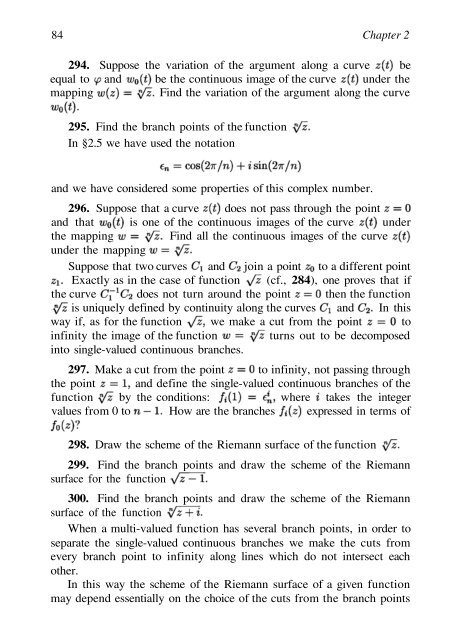Abel's theorem in problems and solutions - School of Mathematics
Abel's theorem in problems and solutions - School of Mathematics
Abel's theorem in problems and solutions - School of Mathematics
You also want an ePaper? Increase the reach of your titles
YUMPU automatically turns print PDFs into web optimized ePapers that Google loves.
84 Chapter 2<br />
294. Suppose the variation <strong>of</strong> the argument along a curve be<br />
equal to <strong>and</strong> be the cont<strong>in</strong>uous image <strong>of</strong> the curve under the<br />
mapp<strong>in</strong>g F<strong>in</strong>d the variation <strong>of</strong> the argument along the curve<br />
295. F<strong>in</strong>d the branch po<strong>in</strong>ts <strong>of</strong> the function<br />
In §2.5 we have used the notation<br />
<strong>and</strong> we have considered some properties <strong>of</strong> this complex number.<br />
296. Suppose that a curve does not pass through the po<strong>in</strong>t<br />
<strong>and</strong> that is one <strong>of</strong> the cont<strong>in</strong>uous images <strong>of</strong> the curve under<br />
the mapp<strong>in</strong>g F<strong>in</strong>d all the cont<strong>in</strong>uous images <strong>of</strong> the curve<br />
under the mapp<strong>in</strong>g<br />
Suppose that two curves <strong>and</strong> jo<strong>in</strong> a po<strong>in</strong>t to a different po<strong>in</strong>t<br />
Exactly as <strong>in</strong> the case <strong>of</strong> function (cf., 284), one proves that if<br />
the curve does not turn around the po<strong>in</strong>t then the function<br />
is uniquely def<strong>in</strong>ed by cont<strong>in</strong>uity along the curves <strong>and</strong> In this<br />
way if, as for the function we make a cut from the po<strong>in</strong>t to<br />
<strong>in</strong>f<strong>in</strong>ity the image <strong>of</strong> the function turns out to be decomposed<br />
<strong>in</strong>to s<strong>in</strong>gle-valued cont<strong>in</strong>uous branches.<br />
297. Make a cut from the po<strong>in</strong>t to <strong>in</strong>f<strong>in</strong>ity, not pass<strong>in</strong>g through<br />
the po<strong>in</strong>t <strong>and</strong> def<strong>in</strong>e the s<strong>in</strong>gle-valued cont<strong>in</strong>uous branches <strong>of</strong> the<br />
function by the conditions: where takes the <strong>in</strong>teger<br />
values from 0 to How are the branches expressed <strong>in</strong> terms <strong>of</strong><br />
298. Draw the scheme <strong>of</strong> the Riemann surface <strong>of</strong> the function<br />
299. F<strong>in</strong>d the branch po<strong>in</strong>ts <strong>and</strong> draw the scheme <strong>of</strong> the Riemann<br />
surface for the function<br />
300. F<strong>in</strong>d the branch po<strong>in</strong>ts <strong>and</strong> draw the scheme <strong>of</strong> the Riemann<br />
surface <strong>of</strong> the function<br />
When a multi-valued function has several branch po<strong>in</strong>ts, <strong>in</strong> order to<br />
separate the s<strong>in</strong>gle-valued cont<strong>in</strong>uous branches we make the cuts from<br />
every branch po<strong>in</strong>t to <strong>in</strong>f<strong>in</strong>ity along l<strong>in</strong>es which do not <strong>in</strong>tersect each<br />
other.<br />
In this way the scheme <strong>of</strong> the Riemann surface <strong>of</strong> a given function<br />
may depend essentially on the choice <strong>of</strong> the cuts from the branch po<strong>in</strong>ts

















